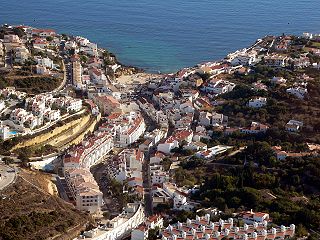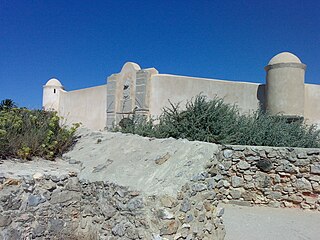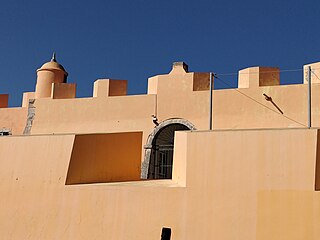
Angústias is one of the three freguesia that comprise the urban area of the city of Horta, on the island of Faial in the Portuguese archipelago of the Azores. This is an economically active, densely populated area. The population in 2011 was 2,418, in an area of 3.79 km2. Due to its commercial nature, the parish is one of the island's primary destinations for tourism, due to the concentration of historical sights and shopping. It contains the localities Caminho do Meio, Courelas, Pasteleiro, Port Pim, Termo da Igreja and Vigia.

The Fort of Leça da Palmeira, or alternately the Castle of Matosinhos is a 17th-century fort located in civil parish of Leça da Palmeira, municipality of Matosinhos in the Greater Porto region of Portugal.

The Fort of São Sebastião de Caparica also known as the Tower of São Sebastião or Fortress of the Old Tower is a medieval fortification located in Monte da Caparica, civil parish of Caparica, in the municipality of Almada, in the Portuguese central region of Península de Setúbal.

The Fort of Our Lady of the Incarnation is a small fortification in the civil parish of Carvoeiro, municipality of Lagoa, in Portuguese Algarve.

The Fort of Guincho, also known as the Fort of Velas, is located at the edge of the Praia do Abano, along the southern edge of the coast of the civil parish of Alcabideche, in Cascais Municipality, Lisbon District, Portugal.. It was classified as Property of Public Interest by the national government on 29 September 1977, but today stands in a state of decay, even after studies to remodel the location as a visitors centre for the nearby Sintra-Cascais Nature Park.

The Fort of São Pedro do Estoril, also known as the Fort of Poça, is a medieval fortification, along the coast of the civil parish of Estoril, in the municipality of Cascais. Situated on the beach of Poça, the Fort was part of a group of fortifications during the Joanino era of Portuguese monarchs, built between 1642 and 1648 to form a defensive line between the Fort of São Julião da Barra and Cabo da Roca.

The Fort of São Jorge is located on the coastal highway EN 247, near the Oitavos dunes, in the parish and municipality of Cascais, Lisbon district, Portugal. It was one of a series of forts stretching from the Tower of Belem close to Lisbon to Cabo da Roca. It is now a museum.

The Citadel of Cascais is a set of fortifications built between the 15th and 17th centuries to defend the Cascais coastline and River Tagus estuary and to protect against attacks on the capital of Portugal, Lisbon. The citadel incorporates three separate developments, the tower of Santo António de Cascais, the Fortress of Our Lady of Light, and the former Royal Palace area.

The São Julião da Barra Fort is the largest and most complete military defense complex in the Vauban style remaining in Portugal. It is located in São Julião da Barra, on the point of São Gião, in the parish of Oeiras e São Julião da Barra, Paço de Arcos e Caxias, Oeiras Municipality, Lisbon District. Considered in the past as the most important maritime fortification in the country, it had originally, together with the Fort of São Lourenço do Bugio, the role of controlling access to the port of Lisbon. It is currently the official residence of the Portuguese Minister of National Defence.

The Fort Nossa Senhora da Luz, also known locally as Castle of Senhora da Luz is a fort in the civil parish of Luz, municipality of Lagos in the Portuguese Algarve, classified as a Property of Public Interest.

The Fort of Cresmina, also known as the Fort of Crismina, is located at the southern end of Cresmina beach, in the municipality of Cascais, Lisbon District, in Portugal. Originally built in 1762 to protect Cresmina beach from landings, it was transferred to private ownership in 1889. As of 2021 it was in the process of being converted into a restaurant.

The Fort of Paimogo, also known as the Fort of Our Lady of the Angels of Paimogo, stands in a dominant position on Paimogo beach near the town of Lourinhã, Lisbon District in Portugal Constructed in 1674, it ceased to serve a military function in 1834 and is now under threat from coastal erosion. The fort presents an almost unique example of a fort from that period that has not undergone subsequent modification.

The Fort Nossa Senhora da Consolação, also known as Fort of Consolação Beach is located on the Atlantic coast of Portugal in the parish of Atouguia da Baleia, in the municipality of Peniche in Leiria District. It was built in 1645 during the Portuguese Restoration War on the initiative of D. Jerónimo de Ataíde, 6th Count of Atouguia and Lord of Peniche.

The Fort of Milreu, also known as the Fort of St. Peter of Milreu, is situated on the Atlantic coast 3km north of the town of Ericeira in Lisbon District of Portugal. Part of a programme to extend Portugal's coastal defences, it was built between 1670 and 1675.

The Fort of Giribita, also referred to as the Fort of Our Lady of Porto Salvo and the Fort of Ponta do Guincho, is located on the right bank of the Tagus estuary, in the municipality of Oeiras, District of Lisbon, in Portugal. It was completed in 1649 during the Portuguese Restoration War (1640-1668), as part of the fortifications of Lisbon that stretched from Cabo da Roca on the Atlantic coast to Belém Tower close to Lisbon. It could exchange crossfire with the Fort of São Bruno to its east.

The Fort of São João das Maias, also known as the Fort of Oeiras, is located on the right bank of the River Tagus estuary, in the municipality of Oeiras in the Lisbon District of Portugal. It was constructed between 1644 and 1653. Until 2010 it had been allowed to fall into a state of advanced degradation but in that year it was restored.

The Fort of Nossa Senhora das Mercês de Catalazete, also known as the Fort of Catalazete, is located on the right bank of the River Tagus estuary in the municipality of Oeiras in the Lisbon District of Portugal. The fort dates back to 1762, when a small battery was erected on a site between the Fort of São Julião da Barra and the Fort of Santo Amaro do Areeiro, with the purpose of strengthening the defence provided by those two forts.

The Fort of Ponta da Bandeira, also known as Pau da Bandeira Fort ; Fort of Nossa Senhora da Penha de França ; the Fort of Registo ; or the Fort of Lagos is situated in the city of Lagos, in the Faro District of Portugal. It was built in the 17th century, as one of the main components of a system of maritime fortifications to defend the city, then headquarters of the military government of the Algarve. Significant restoration work has been carried out over the years and the fort is considered to be one of the best-preserved 17th century fortifications in the Algarve region.
The Fort of Trafaria is a fort in Portugal. Dating back to 1683, it has never been used in battle.

Fort São João Baptista, also known as Fort of Nossa Senhora da Assunção, is located at the mouth of the river Ave, in the town of Vila do Conde, district of Porto, in Portugal.





















